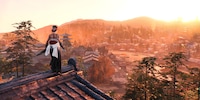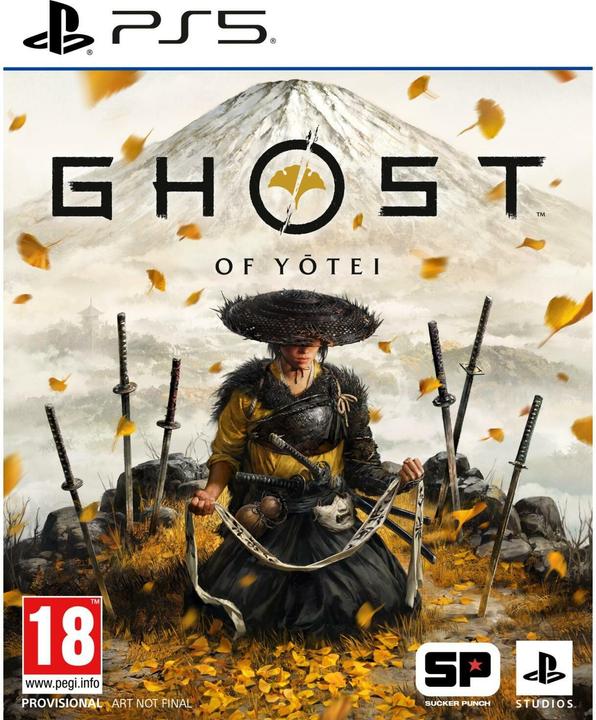

Ghost of Yōtei review: is this still open world?
Ghost of Tsushima set off a veritable tsunami of samurai hype five years ago. Now its successor Ghost of Yōtei is opening up the next chapter. Will protagonist Atsu’s adventure in Hokkaido live up to the high expectations?
Ghost of Yōtei is like one of those childhood memories I’m quite sure happened. Holidays in Italy, my mother chain-smoking through the Gotthard Tunnel with the windows up, and me, spending my pocket money in the arcade between Mortal Kombat and the coin pusher. It was the best holiday of my life.
That’s how Ghost of Yōtei feels for me. Like a childhood memory, a «best-of» experience. Not much new has been added since Ghost of Tsushima, and that’s a good thing. After all, I described it as my perfect game. It’s the cinematic staging of an open world that follows very clear patterns. An open stage for short or longer stories with clear video game rules.
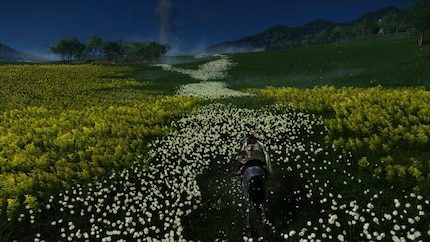
Source: Simon Balissat
While the obsession for realism leads to my horse’s testicles shrivelling in the cold in Red Dead Redemption 2, fields of flowers instead serve as a speed boost for my stallion in Ghost of Yōtei. Any ledges I can reach by climbing are marked with white bird poop. Fast travel isn’t hidden behind unnecessary gimmicks or requires resources. If I need more energy, I set up camp on the spot. Resources light up noticeably, and I pop them in my pocket without any unnecessary animation.
Ghost of Yōtei is a video game and always lets me know that. This comes at the expense of immersion, which in the end never bothers me since Ghost of Yōtei is so freaking cool and easy to access. Right from the start.
Take revenge on the dragon and his friends
It’s 1603. I play as Atsu, whose family was murdered in front of her eyes sixteen years ago in her native Hokkaido. Atsu survived the assassination attempt, fled to Japan’s mainland and fought as a mercenary in the Battle of Sekigahara. Now she returns to her native Hokkaido to take revenge on her family’s six murderers and become the legendary ghost of Yotei.
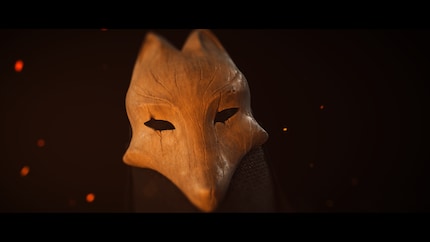
Source: Sony
As a stranger in my own homeland, I first ask locals for advice, take on jobs as a bounty hunter and train with masters in the art of weaponry. Locals provide me with gossip about the gang of murderers known as the Yotei Six, which I gradually track down and bring to justice.
How much freedom does the open world need?
Strangers become friends, visiting me around the campfire and offering tips and goods in the next village. In conversation, they talk about nice bathing ponds, shrines, wolf caves and other places. I mark them in a simple «assign the snippet to the right spot on the map» game or file them in a card index that serves as my quest log. Smaller tasks await me at just such locations, granting me more health, new talismans, armour or other bonuses.
Classic open-world fare for now. The process is always similar: ride to a place, complete a course or defeat an enemy, collect a reward. Sometimes a rebellious NPC surprises me by trying to help with the quest, then stabbing me in the back. Or a bear suddenly emerges from the thicket and jumps me. But in general, these open-world events are short snacks, reduced to the essentials and yet varied.
Main missions, immediately recognisable by the golden icon, are more linear. They’re usually staged in closed areas, so I can’t escape from them. The open world recedes into the distance and makes way for scripted action set pieces.
Grenades come crashing down on me, whole armies fight alongside me and we attack the enemy hordes together, usually ending in an extravagant one-on-one. In these spectacularly staged encounters, katanas gleam in the sunset and colourful leaves whirl through the air. True pleasure.
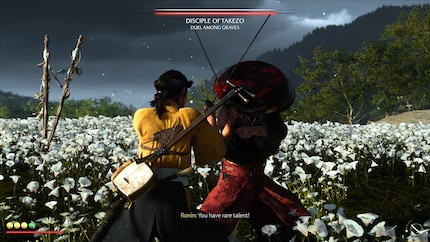
Source: Domagoj Belancic
Other missions require skilful sneaking and waiting, child’s play thanks to the «seeing through walls» mechanic. I often can’t choose between sneaking into battle from the shadows or jumping in head-on with my sword raised, as the game dictates. Sometimes I have to sneak, sometimes enemies come at me in hordes. As a fan of role-playing games, I’d have expected more flexibility here.
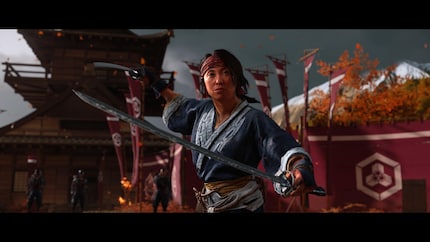
Source: Domagoj Belancic
Razzle-dazzle as far as the eye can see
Graphically, Ghost of Yōtei is stunning at first glance. Yes, there are angular shadows, plastic-faced NPCs staring into space and trees clipping into mountains. But that’s not important, the overall scenery is impressive.
The developers already proved with the predecessor that they can recreate Japan beautifully. Now Sucker Punch is going one better – at the expense of realism. All four seasons are represented in the environments. Completely illogical, but it provides variety and that wow factor. Sometimes I ride through snow-covered forests, a few kilometres further on cherry blossoms cover the rolling hills. Around the corner, trees are bathed in the deep red of autumn leaves, and in the next area I spot lush green meadows and the sun is blazing like summer.
Yes, it very much glorifies Far-Eastern culture. But it all looks so beautiful!
When I complete a mission, the camera switches to a wide-angle view that could work just as well on a postcard. The deep thump of a drum and Japanese characters gently getting blown away by the wind underline my victory. When I stand before a duel, the camera zooms in on the eyes of each fighter as if this were a samurai epic by Akira Kurosawa. Only very few studios manage such epic productions. In terms of graphic drama, Ghost of Yōtei ranks right up there with greats like Elden Ring or Death Stranding.
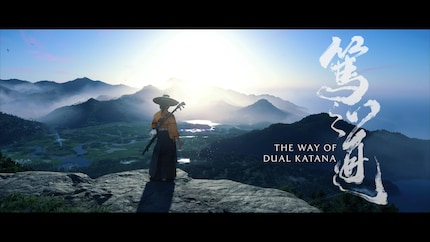
Source: Domagoj Belancic
Rock, Paper, Punch
The same can’t be said of the gameplay. While Elden Ring and Death Stranding are often unwieldy in their gameplay, this samurai adventure is as accessible as a Dan Brown novel.
Block, light attack, heavy attack. The different stances from Tsushima are gone – instead, there are five different weapons that relate to each other in a rock-paper-scissors system. The long spear is useful against claws attached to chains, called kusarigama. To beat a spear, I need the double sword again. Finally, kusarigama are effective against shields. I switch between weapons quickly, while enemy units wait patiently to attack. The result is a ballet of changing weapons, blocking and dodging. The harder the difficulty, the more I have to resort to various rapid-fire weapons such as throwing knives or smoke bombs, which give me some distance and time.
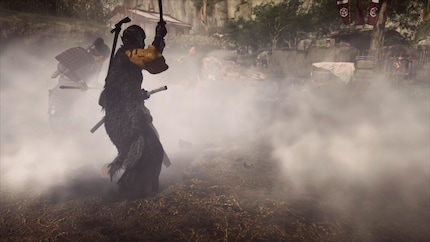
Source: Simon Balissat
For ranged attacks, I also have two bows and a musket at my disposal. The standard difficulty Medium is extremely forgiving about wrong weapon choices initially. I played most of the game on Deadly, which was only added to the predecessor Ghost of Tsushima with a later update. It’s by far the most fun level for me.
One or two hits are enough to kill me. But my enemies aren’t sandbags that can take twenty sword blows either. They’re dead after an unblocked hit too. An eye for an eye, tooth for a tooth. Blindly rushing in is a good way to die quickly, tactical use of all weapons and utilities is mandatory. In certain situations, I get help in the form of a wolf. I won’t reveal more, spoilers beware.
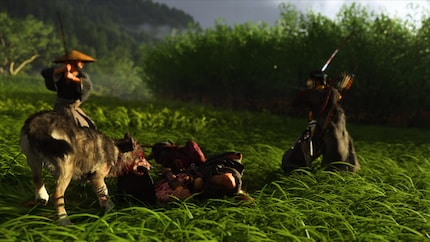
Source: Simon Balissat
Luckily not a role-playing game
Fortunately, Ghost of Yōtei dispenses with classic role-playing elements and attributes such as Strength, Intelligence and Skill. Instead, I find armour that offers me bonuses. One armour makes me sneak better, and headshots cause more damage with another. I can also equip various talismans that offer their own bonuses, saving armour and talisman combos in one of five slots.
It couldn’t be simpler or more accessible. This encourages me to constantly experiment with new builds. Ghost of Yōtei does away with numbers altogether. Instead of 12.3 per cent more damage, all you see is «moderate damage increase». Sorry to all you spreadsheet min-max freaks!
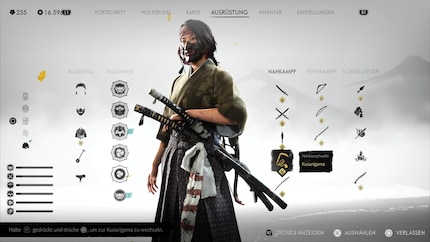
Source: Simon Balissat
And finally, there are skills you can unlock that actually feel like they do something. Anyone who was overwhelmed by the sheer number of skills in God of War will love this game. Almost every skill point invested is immediately noticeable. For example, you can silently eliminate two enemies instead of one, or unlock a simple combo that does more damage.
Stick to the rules!
Another must-have for me is a successful Japanese dub. Yes, I didn’t catch some of the dialogue properly because I couldn’t read the subtitles in all the rush. But as a JRPG and anime veteran, I’m used to that. And it feels strange to me when Japanese samurai speak German or English in the 15th century. I need that bit of immersion. In contrast to its predecessor, the lip movements in the Japanese version are now right too.
The soundtrack provides that complete samurai movie kick, arranging traditional shamisen sounds in Italo-Western style, sometimes combining them somewhat clumsily with overly short Japanese vocals. This legendary scene from Red Dead Redemption sends its regards. It’s only logical that these sequences also last a little too short to craft an atmosphere.
This is both the great strength and biggest problem in Ghost of Yōtei. Everything is reduced down so much that individual set pieces feel incredible and atmospheric to me. Something is always happening. Of course, this requires clear rules I can’t break under any circumstances. Several times I stood in front of a cave I couldn’t open, although the boarded up entrance suggested otherwise. The cave could only be opened at the right time in the story. This makes detailed exploration of the open world pointless, since you’ll always come across deserted locations. As soon as I got used to the rules again and only followed the hints that the game provided, the world opened up once more.
In the end, after 30 hours, what remains is a wonderful samurai epic with rough edges that sticks to the essentials and leaves out ballast. Is it the perfect game? Definitely not. My holiday in Italy wasn’t the perfect vacation either. But they’ve stayed with me to this day.
We discussed Ghost of Yōtei in the latest episode of our Swiss German A Tech Affair podcast, the discussion starts at 35:46.
In a nutshell
The open world is dead, long live Ghost of Yōtei
The world of Ghost of Yōtei is vast, beautiful and serves merely as a vessel for the various tasks I complete in it. While the open world is a character in its own right in other games, here, it serves as an eye-catcher between adventures. Not that this bothers me, even as an explorable menu it’s beautifully designed.
Behind the chic façade lies a samurai action epic featuring Atsu as our protagonist, captivating me as a cool and conflicted anti-heroine. The story is predictable, much of it a single video game cliché. Whatever. I like the stripped-down combat system and accessible switching between different archetypes at the touch of a button. Sometimes I’m a ninja in the shadows, sometimes a sniper and other times even a human tank.
One thing always stays the same: I feel like a badass. This may be too simple and one-dimensional for some. But the samurai action, reduced to its purest form, really gets me going.
Pro
- Easily accessible and flexible combat system
- Beautifully cinematic presentation
- Surprising side tasks
- Classic revenge story
Contra
- Open world often looks like a façade
- Graphical imperfections
- Classic revenge story

When I flew the family nest over 15 years ago, I suddenly had to cook for myself. But it wasn’t long until this necessity became a virtue. Today, rattling those pots and pans is a fundamental part of my life. I’m a true foodie and devour everything from junk food to star-awarded cuisine. Literally. I eat way too fast.
Which films, shows, books, games or board games are genuinely great? Recommendations from our personal experience.
Show all

